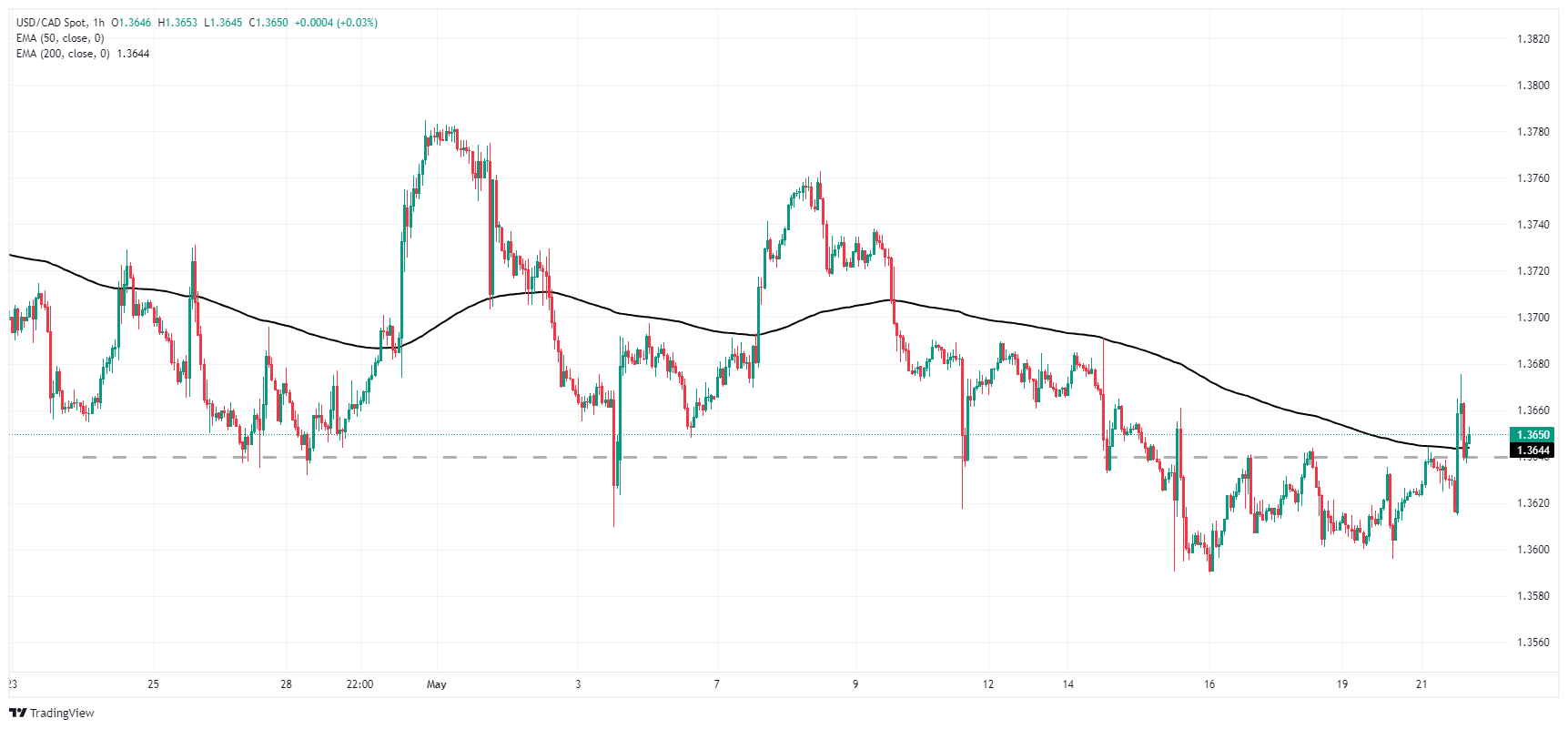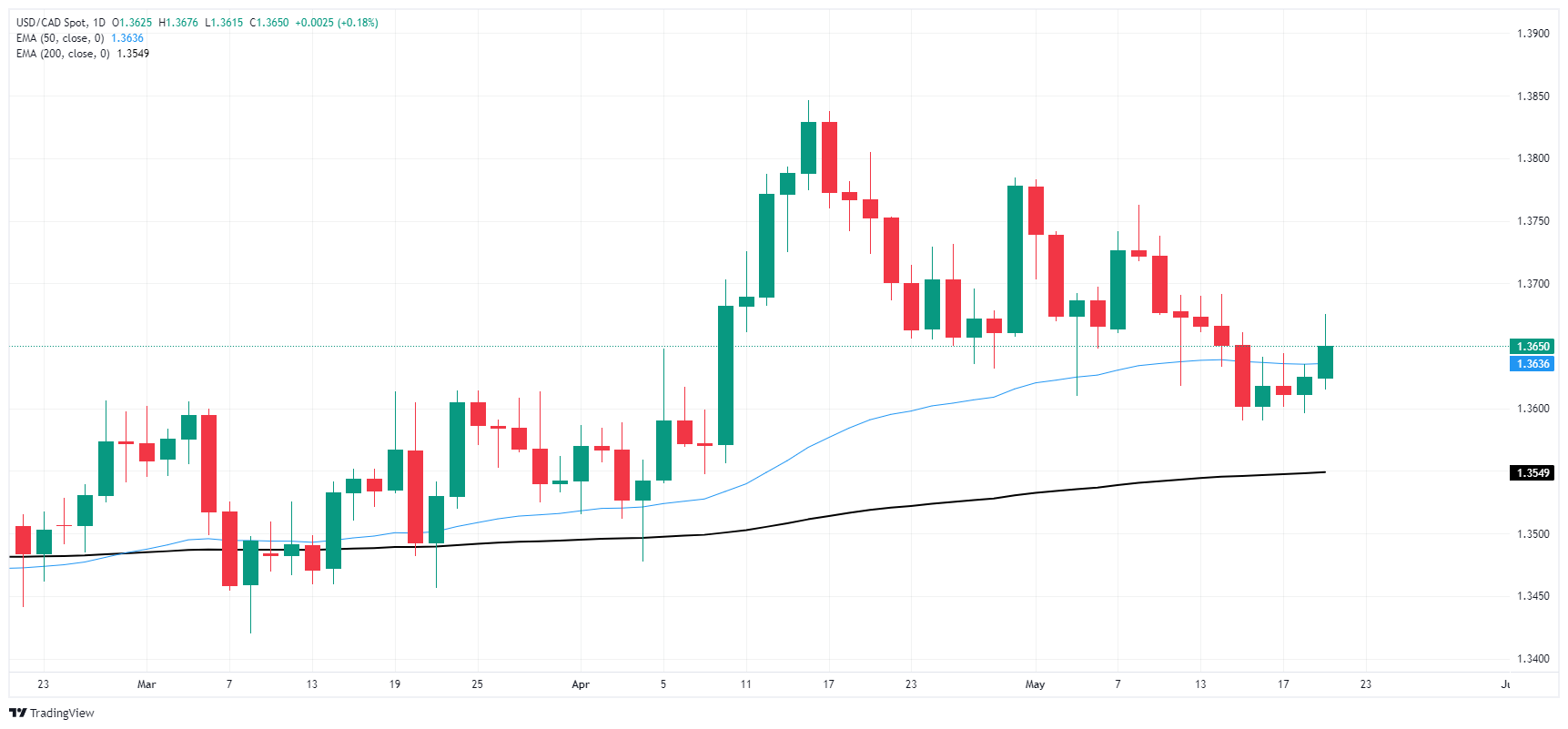- Analytics
- News and Tools
- Market News
- Canadian Dollar eases back on Tuesday after CPI inflation cools
Canadian Dollar eases back on Tuesday after CPI inflation cools
- Canadian Dollar broadly lower as inflation tempers in April.
- Canada finds easing price pressures, odds of BoC June rate cut rise.
- Canadian Retail Sales due at the end of the week.
The Canadian Dollar (CAD) is broadly softer on Tuesday, falling across the board and deflating around a fifth of a percent against the US Dollar (USD) after Canadian Consumer Price Index (CPI) inflation eased further in April. Markets are increasing their bets of a rate cut from the Bank of Canada (BoC) in June.
Canadian CPI inflation eased broadly in line with expectations, but the BoC’s Core CPI print dropped to its lowest point since April of 2021. With price pressure easing, market bets of a June rate cut from the BoC have risen to 48%, from 40% prior to Canada’s CPI print.
Daily digest market movers: Canadian Dollar slides in the face of easing inflation
- Canadian headline CPI inflation in April ticked down to 0.5% MoM, matching forecasts and easing from the previous 0.6%.
- YoY Canadian CPI inflation also met market forecasts, printing at 2.7% versus the previous 2.9%.
- The BoC’s Core CPI for the year ended April eased to 1.6%, down from the previous 2.0% and hitting a three-year low.
- Elsewhere in the market, Fedspeak continues to dominate overall sentiment as policymakers from the US Federal Reserve (Fed) make a slew of appearances in an effort to inject verbal confidence in markets.
- Canadian Retail Sales are due at the end of the week. Median market forecasts are hoping for a slight rebound to a flat 0.0% from the previous -0.1%.
Canadian Dollar PRICE Today
The table below shows the percentage change of Canadian Dollar (CAD) against listed major currencies today. Canadian Dollar was the strongest against the New Zealand Dollar.
| USD | EUR | GBP | JPY | CAD | AUD | NZD | CHF | |
|---|---|---|---|---|---|---|---|---|
| USD | 0.00% | -0.04% | -0.08% | 0.16% | 0.01% | 0.16% | 0.00% | |
| EUR | -0.01% | -0.04% | -0.08% | 0.14% | 0.04% | 0.13% | 0.01% | |
| GBP | 0.04% | 0.04% | -0.06% | 0.20% | 0.05% | 0.19% | 0.04% | |
| JPY | 0.08% | 0.08% | 0.06% | 0.25% | 0.08% | 0.22% | 0.08% | |
| CAD | -0.16% | -0.14% | -0.20% | -0.25% | -0.15% | -0.01% | -0.16% | |
| AUD | -0.01% | -0.04% | -0.05% | -0.08% | 0.15% | 0.14% | 0.00% | |
| NZD | -0.16% | -0.13% | -0.19% | -0.22% | 0.01% | -0.14% | -0.15% | |
| CHF | -0.00% | -0.01% | -0.04% | -0.08% | 0.16% | 0.00% | 0.15% |
The heat map shows percentage changes of major currencies against each other. The base currency is picked from the left column, while the quote currency is picked from the top row. For example, if you pick the Canadian Dollar from the left column and move along the horizontal line to the US Dollar, the percentage change displayed in the box will represent CAD (base)/USD (quote).
Technical analysis: Canadian Dollar backslides but remains in familiar technical territory
The Canadian Dollar (CAD) is moving in one direction on Tuesday, heading lower against nearly all of its major currency peers. The CAD is down a third of a percent against the broadly-recovering Japanese Yen (JPY), and has shed a fifth of a percent against the USD.
USD/CAD rose to its highest bids in a week, threatening to solidify a bullish rejection from the 50-day Exponential Moving Average (EMA) from 1.3636. The pair is still down from last month’s peak bids near 1.3850, but a long-term technical floor is priced in at the 200-day EMA from 1.3549.
USD/CAD hourly chart
USD/CAD daily chart
Canadian Dollar FAQs
The key factors driving the Canadian Dollar (CAD) are the level of interest rates set by the Bank of Canada (BoC), the price of Oil, Canada’s largest export, the health of its economy, inflation and the Trade Balance, which is the difference between the value of Canada’s exports versus its imports. Other factors include market sentiment – whether investors are taking on more risky assets (risk-on) or seeking safe-havens (risk-off) – with risk-on being CAD-positive. As its largest trading partner, the health of the US economy is also a key factor influencing the Canadian Dollar.
The Bank of Canada (BoC) has a significant influence on the Canadian Dollar by setting the level of interest rates that banks can lend to one another. This influences the level of interest rates for everyone. The main goal of the BoC is to maintain inflation at 1-3% by adjusting interest rates up or down. Relatively higher interest rates tend to be positive for the CAD. The Bank of Canada can also use quantitative easing and tightening to influence credit conditions, with the former CAD-negative and the latter CAD-positive.
The price of Oil is a key factor impacting the value of the Canadian Dollar. Petroleum is Canada’s biggest export, so Oil price tends to have an immediate impact on the CAD value. Generally, if Oil price rises CAD also goes up, as aggregate demand for the currency increases. The opposite is the case if the price of Oil falls. Higher Oil prices also tend to result in a greater likelihood of a positive Trade Balance, which is also supportive of the CAD.
While inflation had always traditionally been thought of as a negative factor for a currency since it lowers the value of money, the opposite has actually been the case in modern times with the relaxation of cross-border capital controls. Higher inflation tends to lead central banks to put up interest rates which attracts more capital inflows from global investors seeking a lucrative place to keep their money. This increases demand for the local currency, which in Canada’s case is the Canadian Dollar.
Macroeconomic data releases gauge the health of the economy and can have an impact on the Canadian Dollar. Indicators such as GDP, Manufacturing and Services PMIs, employment, and consumer sentiment surveys can all influence the direction of the CAD. A strong economy is good for the Canadian Dollar. Not only does it attract more foreign investment but it may encourage the Bank of Canada to put up interest rates, leading to a stronger currency. If economic data is weak, however, the CAD is likely to fall.
© 2000-2024. All rights reserved.
This site is managed by Teletrade D.J. LLC 2351 LLC 2022 (Euro House, Richmond Hill Road, Kingstown, VC0100, St. Vincent and the Grenadines).
The information on this website is for informational purposes only and does not constitute any investment advice.
The company does not serve or provide services to customers who are residents of the US, Canada, Iran, The Democratic People's Republic of Korea, Yemen and FATF blacklisted countries.
Making transactions on financial markets with marginal financial instruments opens up wide possibilities and allows investors who are willing to take risks to earn high profits, carrying a potentially high risk of losses at the same time. Therefore you should responsibly approach the issue of choosing the appropriate investment strategy, taking the available resources into account, before starting trading.
Use of the information: full or partial use of materials from this website must always be referenced to TeleTrade as the source of information. Use of the materials on the Internet must be accompanied by a hyperlink to teletrade.org. Automatic import of materials and information from this website is prohibited.
Please contact our PR department if you have any questions or need assistance at pr@teletrade.global.















